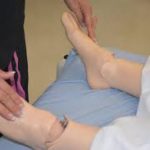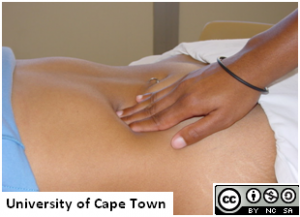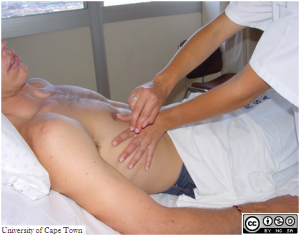
4.5 Health Assessment and Clinical Judgment
This chapter will introduce the concept of clinical judgment, its significance to nursing practice, quality of care and how health assessment is an integral component of this concept. Sound clinical judgment requires nurses to be competent in several aspects of assessment such as recognition and interpretation of cues , which are prerequisites of taking actions to address the identified problems. This chapter will introduce overview of clinical judgment and health assessment, types of data, types of assessment, techniques of physical examination and positioning during physical examination.
Health Assessment and Clinical Judgment
Sound nursing clinical judgment is at the core of competent and safe client care (Dickison et al, 2019). Clinical judgment is made up of actions and behaviors that depend on cognitive, psychomotor, and affective processes. Accurate patient assessment is needed to provide appropriate intervention. Assessment includes recognizing relevant cues, not only from direct patient assessment, but also from the environment, health history, and laboratory values. This is an essential part of clinical judgment, as the nurse must then analyze these cues, form hypotheses about the relationships among the cues, and prioritize problems to act on. Benner (2004) describes nursing practice as varied and complex and often underdetermined, and claims that good nursing practice requires that the nurse develop skillful ethical comportment and use of good clinical judgment informed by scientific evidence and technological development. Furthermore, Benner (2004) asserts that perceptual acuity in recognizing salient signs, symptoms, and responses to therapies are required for the clinician to use good clinical judgment in particular cases. These illustrations of the necessity of clinical judgment support the need for the nurse be competent in health assessments, and that health assessment must be informed by sound clinical judgment as well.
The National Council of State Boards of Nursing (NCSBN) Clinical Judgment Measurement Model synthesizes three established and accepted paradigms for clinical judgment that are used in educating nurses as a framework, and in the creation of test items to test clinical judgment in licensure examinations (Dickinson, et al 2019).
The nursing process includes five components of problem solving: assessment, nursing diagnosis, planning, implementation, and evaluation. It is a useful tool for beginning students as a foundation for problem-solving client issues; it does not encompass the complexities of clinical reasoning and the factors that influence it (Tanner, 2006). The NCSBN’s six-step clinical judgment model delineates the process for making clinical judgments as follows (Billings and Kowalski, 2019):
Recognize cues
- identifying cues from the environment
- patient observations
- information from health records such as laboratory values, health history, prescriptions
- distinguishing relevant from irrelevant information
Analyze cues
- using knowledge to interpret cues and make inferences
- recognizing relationships among data points
Prioritize hypotheses
- listing possible client problems
- identifying priorities
Generate solutions
- identifying possible solutions to the problem
- selecting solutions with evidence for best outcomes
Take action
- implementing the solution
Evaluate outcomes
- determining results of actions
- changes in vital signs
- effects of treatments and pharmacologic interventions
- compare actual outcomes with expected outcomes
Types of Health Assessment
Health assessments are performed by nurses and other providers alike. The following are the types of health assessments performed by nurses in various situations. A health assessment is guided by the nurse’s knowledge of anatomy, physiology, and pathophysiology; their therapeutic communication skills; and other things.
- Comprehensive head-to-toe assessments are done when a patient is admitted. This is often called a nursing admission assessment. Shorter comprehensive head-to-toe assessments are also performed at the beginning of each shift, and when it is determined to be necessary according to the patient’s hemodynamic status and context.
- Brief physical assessments are done as necessary and to identify changes in a patient’s status and for comparison with the previous assessment.
- Focused assessments are done in response to a specific problem recognized by the nurse as requiring further assessment of a particular body system.
- Emergency assessments are done in emergency situations. Because of the emergent nature of many health conditions, the nurse may modify the assessment to obtain necessary information to provide emergent care.
- A routine physical assessment reveals information to supplement a patient’s database. The assessment is documented according to agency policy, and unusual findings are reported to appropriate members of the health care team. Ongoing, objective, and comprehensive assessments promote continuity in health care.
The ability to think critically and interpret patient behaviors and physiologic changes is essential. The skills of physical assessment are powerful tools for detecting both subtle and obvious changes in a patient’s health. The nurse must develop competency in patient assessment in order to provide safe patient care. A more detailed discussion of the most common types of assessment performed will be discussed in the next chapters of this guide.
Types of Data
Subjective Data
Information that is reported by the patient or a reliable historian who is knowledgeable about the patient’s health-related information is organized in a report called a health history. The health history is taken and updated with each patient encounter as necessary; such information informs patient care. A more detailed discussion of health history is found in Chapter 3 of this book.
Objective Data
Objective assessment data includes that which is observable and measurable (Jarvis, 2012). Objective data observation and measurement is done through a systematic physical assessment procedure using various assessment techniques, measurement of vital signs, and correlation of physical manifestations with laboratory and diagnostic findings.
Observation: using the senses (hearing—heart sounds; touch—moisture; smell—wounds [odor])
Measurement: value of a construct related to an assessment technique, compared to normal values or condition (pain using the pain scale, where the normal value is 0 [no pain]; weight as measured by a weighing scale; tenderness; etc.)
Techniques of Physical Assessment
The standard method of physical examination involves the following techniques.
- Inspection, considering clues from what we see.
- Palpation, gathering information from what we feel or what the patient feels as we palpate.
- Percussion, listening to different percussion notes and interpreting these in the context of the reason for visit.
- Auscultation, using a stethoscope to listen more intensely to sounds within the body.
All of these aspects of examination rely on a knowledge of what is normal in order to identify any abnormalities. Physical assessment also requires some knowledge of common patterns of presentation or manifestations associated with different conditions.
All of the information gathered using these four techniques will help nurses formulate nursing diagnoses or determine the patient’s functional health problems. When we inspect our patient to discover relevant clues, we look at the patient as a whole. Are they appropriately dressed for the current weather? Their demeanor? Their expression? Does their facial expression indicate that they are in pain? Their gait? Their body shape? If we are focused on specific systems, we may inspect one or more parts of the body related to that system.
Our hands can tell us many things about the body of the patient we are examining. As we shake hands with the patient at the beginning of the consultation, we are aware if the patient’s hand is hot, which may indicate a fever; cold, which may indicate peripheral vascular problems; or clammy, which may indicate sepsis or cardiogenic shock. All within the few short seconds of a handshake. We can assess their muscle tone, limb weakness, or spasticity through palpation. As we move into specific system examinations, we can palpate for tactile fremitus, respiratory, masses, abdomen or skin, pulses, circulation, lymph nodes, systemic infection or crepitus, musculoskeletal system.
One of the most difficult techniques for nurses to learn is percussion of the body cavities. Percussion can give us clues to several health conditions by the change in the percussion note or sound when we percuss over solid, bone, tumor, fetus, feces, or fat or liquid, pleural effusion, urinary bladder ascites, or gas, flatus, fully expanded lung tissue, etc. The technique is to use the middle or index and middle fingers of your dominant hand as the drumstick and drop it smartly onto the middle phalanx of your non-dominant middle finger which rests on the patient’s body. The drum beat noise that this produces indicates whether solid, liquid, or gas is present in that body cavity. Here are some examples of the sounds you could hear. Solid, over bone; liquid, over ascites; gas, over chest cavity.
Auscultation is the act of listening to body parts and assessing the sounds made using a stethoscope. There are several types of stethoscope and it is important to acquire a stethoscope which is appropriate to yourself and suitable for your patient group. For example, if you have a hearing deficit, an electrically amplified stethoscope may be useful for you. If you work mainly with babies and children, you may need a pediatric stethoscope, which has a smaller head. You need to accustom yourself to your chosen stethoscope, ensuring that the ear pieces are inserted pointing towards your face and not towards the back of your head. This way, they follow the ear canal and transmit sound more efficiently.
How to Perform the Techniques of Physical Examination
Physical assessment techniques usually occur in the following order: inspection, palpation, percussion, and auscultation. Use them in sequence—unless you’re performing an abdominal assessment. Palpation and percussion can alter bowel sounds, so you’d inspect, auscultate, percuss, then palpate an abdomen.
1. Inspection
Inspect each body system using vision, smell, and hearing to assess normal conditions and deviations. Assess for color, size, location, movement, texture, symmetry, odors, and sounds as you assess each body system.
2. Palpation
Palpation requires you to touch the patient with different parts of your hands, using varying degrees of pressure. Because your hands are your tools, keep your fingernails short and your hands warm. Wear gloves when palpating mucous membranes or areas in contact with body fluids. Palpate tender areas last.
Light palpation
- Use this technique to feel for surface abnormalities.
- Depress the skin ½ to ¾ inch (about 1 to 2 cm) with your finger pads, using the lightest touch possible.
- Assess for texture, tenderness, temperature, moisture, elasticity, pulsations, and masses.
Deep palpation


- Use this technique to feel internal organs and masses for size, shape, tenderness, symmetry, and mobility.
- Depress the skin 1½ to 2 inches (about 4 to 5 cm) with firm, deep pressure.
- Use one hand on top of the other to exert firmer pressure, if needed.
3. Percussion
Percussion involves tapping your fingers or hands quickly and sharply against parts of the patient’s body to help you locate organ borders, identify organ shape and position, and determine if an organ is solid or filled with fluid or gas.
Direct percussion
This technique reveals tenderness; it’s commonly used to assess an adult’s sinuses.
- Using one or two fingers, tap directly on the body part.
- Ask the patient to tell you which areas are painful, and watch his face for signs of discomfort.
Indirect percussion
This technique elicits sounds that give clues to the makeup of the underlying tissue. Here’s how to do it:

- Press the distal part of the middle finger of your nondominant hand firmly on the body part.
- Keep the rest of your hands off the body surface.
- Flex the wrist of your nondominant hand.
- Using the middle finger of your dominant hand, tap quickly and directly over the point where your other middle finger touches the patient’s skin.
- Listen to the sounds produced.
4. Auscultation
Auscultation involves listening for various lung, heart, and bowel sounds with a stethoscope.
- Provide a quiet environment.
- Make sure the area to be auscultated is exposed (a gown or bed linens can interfere with sounds.)
- Warm the stethoscope head in your hand.
- Close your eyes to help focus your attention.
How to auscultate
- Use the diaphragm to pick up high-pitched sounds, such as first (S1) and second (S2) heart sounds. Hold the diaphragm firmly against the patient’s skin, using enough pressure to leave a slight ring on the skin afterward.
- Use the bell to pick up low-pitched sounds, such as third (S3) and fourth (S4) heart sounds. Hold the bell lightly against the patient’s skin, just hard enough to form a seal. Holding the bell too firmly causes the skin to act as a diaphragm, obliterating low-pitched sounds.
- Listen to and try to identify the characteristics of one sound at a time.
Prepare a patient for physical examination
Watch the brief video Assisting with a Complete Physical Examination below. Observe how the nurse prepares the patient to have a physical examination.
References
Introduction to Patient Assessment: https://opentextbc.ca/clinicalskills/chapter/introduction-2/
Learning Clinical (2006). Assessing patients effectively: Here’s how to do the basic four techniques. Nursing 2006: November-December 2006, Volume 8, Issue 2 – p 6
Shinnick, M.A. and Cabrera-Mino, C. ( 2021). Predictors of nursing clinical judgment in simulation. Nursing Education Perspectives. Vol 42, No 2; pp 107-109.
Attribution
This chapter contains material taken from Health Assessment Guide for Nurses by Ching-Chuen Feng, Michelle Agostini, and Raquel Bertiz, and is licensed under a Creative Commons Attribution 4.0 International License.

